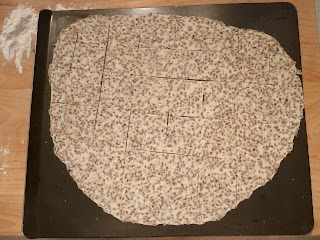Two Years Ago: Grilled Shrimp Greek Salad
I've been wanting to try this recipe for over a year, ever since The Lawyer and I took a geat trip to France. While we were in Burgundy I learned about the classic regional dish called "Poulet (poolay) Gaston Gerard", which translates to "Chicken Gaston Gerard". It was created by the wife of the mayor of Dijon (Madame Gaston Gerard) in 1930 to commemorate a visit by the famous French "Prince of Gastronomy" Curnonsky. If you're a foodie geek like me, that story alone is enough to get you hooked. If not, maybe you'll get hooked when I tell you the dish includes a mustard (Dijon, of course) cream sauce with Gruyere cheese. Now are you interested? I mean, how could it taste bad? Cardboard would taste good with that sauce.
I did some research and discovered that although there are some small variations from recipe to recipe, the standard ingredients are chicken, Dijon mustard, Gruyere cheese, creme fraiche or heavy cream or half in half, and butter, Pretty simple. Many recipes call for bone-in chicken pieces but I prefer to work with boneless skinless chicken just for the ease of cooking and eating. I found truly giant chicken breasts at the store so I first cut them in half horizontally to form thinner chicken cutlets and then again crosswise to make 8 total pieces that were about 3"x 3" - much easier and faster to cook. Can you believe all this came from two chicken breasts? The chickens must have been the size of small turkeys.
The recipe is surprising fast and easy. First you brown the chicken, then place it in a casserole dish and make the sauce in the same saute pan. I used half and half instead of heavy cream, and the resulting sauce was slightly thickened but probably thinner than you would expect from a sauce that contains cheese. I think it's probably because the sauce contains less cheese than a normal "cheese sauce" so the flavor of the mustard can shine. (After all, it is from Dijon France.) That was perfectly OK with me, but if you want your sauce thicker I would use heavy cream and simmer it for a little while longer, or maybe add a little more cheese. The predominant tastes in the sauce are mustard, cheese, and cream in that order. It tastes very French. The sauce is then poured over the chicken and quickly browned under the broiler.
It's wonderful served with rice pilaf, mushrooms and peas, or farro with asparagus tips. I think it's certainly company-worthy and I would call it a special occasion meal if for no other reason than the cheese and cream probably take it out of your weekly rotation. It would make a great birthday meal, for example. And the story alone is worth it. I wonder what that Curnonsky guy thought?
printable recipe
Chicken Gaston Gerard
Serves 4
2 very large or 4 medium boneless skinless chicken
breasts
Salt and freshly ground black pepper
2 tablespoons unsalted butter
1 bay leaf
1 sprig fresh thyme
2 tablespoons dry white wine
1 cup heavy cream or half and half
2 tablespoons Dijon mustard
¾ cup grated Gruyere cheese
¼ cup dry bread crumbs (Panko preferred)
Cut the chicken breasts in half horizontally to make
thinner cutlets, then cut in half crosswise (if the breasts are very large) to
make relatively thin pieces of chicken that are approximately 3” wide by 2-3”
long. You should have 8 pieces either way.
Season the chicken with salt and pepper. Heat a sauté pan to medium-high and melt the
butter. Brown the chicken on the first
side (approximately 4-5 minutes), then flip the chicken and reduce the heat to
low. Add bay leaf, thyme and white wine.
Cook, covered, until the chicken is browned on the second side and fully cooked
through, approximately 6-7 minutes.
Adjust cooking time depending on the thickness of your chicken
pieces. Do not overcook or the chicken
may become dry.
Preheat a broiler.
Remove chicken from the sauté pan and place in a shallow casserole dish
coated with cooking spray. Discard bay
leaf and thyme from the sauté pan and return to medium-high heat. Add the cream and cook until it starts
bubbling, then remove from the heat and stir in the mustard and all but 2
tablespoons of the grated cheese. Pour
the sauce over the chicken, add the rest of the grated cheese and the bread
crumbs to the top, and place under the broiler for 30 seconds or so to
brown. Watch closely so the top doesn’t
burn.
Excellent served with rice pilaf, mushrooms and peas, or
warm farro with asparagus tips.
































